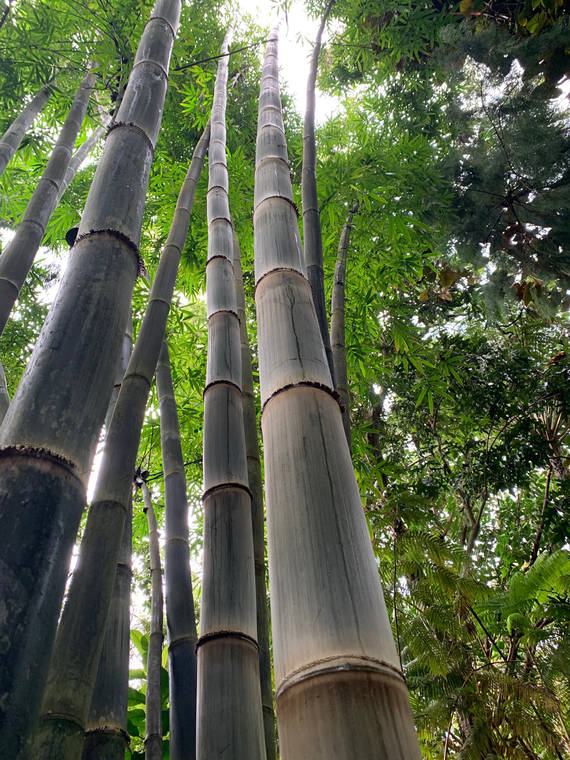There are many lessons to be learned during times when we are home and garden bound.
In my 82 years of life, I have never experienced so much time not being busy with school, work, family or travel.
Bamboo has come to assist me in meditation.
According to Peter Berg and Susan Ruskin of Quindembo Nursery, they imported more than 100 species of noninvasive bamboo. These are suitable for privacy hedges, gorgeous landscape statements, edible shoots, windbreaks and construction.
It is just the right time to sit and meditate, as some species will grow from 1-2 feet in a single day. With patience, one can actually watch them reach upward for the light.
Hawaii’s varied climates and cultural makeup are ideal for bamboo, but until the 1980s there was no serious effort to introduce them. Thanks to the Hawaii Chapter of the American Bamboo Society and Quindembo Nursery, we now have many species to choose.
The Hawaiian ohe kahiko is a tropical clumper, probably originating in Southeast Asia. It is likely Schizostachyum and has been called S. glaucifolium in Hawaii.
With large tracts of land now available for forestry, and our local interest in sustainable agriculture, bamboo could become one of our major resources. It has many uses, commercial and ornamental.
Some folks only know bamboo from their experience with the rampant running species. Needless to say, these types are not for the small garden unless contained. However, they have been used very effectively to stabilize steep slopes prone to erosion.
That is why we find large stands of Phyllostachys running bamboos on the steeps slopes above Waiohinu in Ka‘u or at the back of Manoa Valley and on Maui. Erosion on East Hawaii gulch roads is a serious problem that could be addressed with certain bamboo species.
Bamboos are also excellent cattle feed and have a place in supplying nutritious greens at a low cost. Local growers have been working on the potential of growing bamboos for multiple use sustainable agriculture incorporating the animal feed component.
Bamboos also are a natural for almost any tropical garden. Bamboos vary from forest giants of 120 feet to dwarfs of 6 inches.
Many bamboos are suitable for ornamental purposes. The clump bamboos can be planted in groups for hedges or singly. They spread very slowly and are easy to keep within bounds.
One of the best for sunny locations is the Mexican weeping bamboo. Others to consider are the Bambusa multiplex forms. These delicate clump types range from 10-20 feet high. Other rare clumping types are beginning to show up in our nurseries such as the Chusqueas and Drepanostachyums.
For larger gardens, try Bambusa chungii (tropical blue hedge) and Weaver’s bamboo. These are all clumping types in the 20-40 foot range.
The giant tropical clumping bamboos need plenty of room since they soar from 50-100 feet tall under ideal conditions. This group includes the larger Bambusa, Dendrocalamus, Guadua and Gigantochloa species that can have culms 6-12 inches in diameter.
Favorites are the black culm types such as Hitam, Lako and Gigantochloa atroviolecea. Another favorite spectacular giant is Dendrocalamus brandisii.
Miniature bamboos well suited to container growing are the Sasa species and Shibatea kumasasa. These and other running bamboos such as black bamboo can be kept small or bonsai when contained.
The running bamboos are more difficult to keep in bounds than the clump bamboo. However, many are desirable as ornamentals because of diversity in their habit of growth, appearance and size.
Bamboos do best in a moist, well-drained soil with some organic matter. Apply complete fertilizer such as organic 8-8-8 or manures 4-6 times a year to the planting.
Mulch the soil around the planting to add organic matter, help restrict the growth of weeds and conserve soil moisture. Dead leaves or dry grass clippings can be used for mulch. Apply a layer of mulching material at least 3 inches deep.
For more information about bamboo, call the UHCTAHR Master Gardeners at 322-4893 in Kona or 981-5199 in Hilo.

